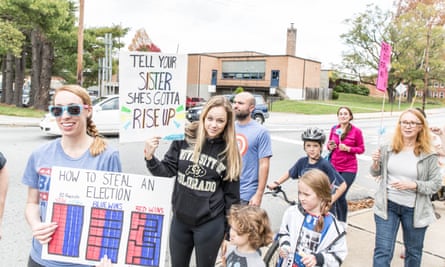Runners taking part in a 5km race in a small city in North Carolina on Saturday afternoon could have been forgiven for feeling dizzy, as they followed a zigzag course that took them, literally, all around the houses.
The event was intended as a live demonstration of the absurdity and insidiousness of the way voting boundaries have been redrawn – or gerrymandered – in Asheville, a liberal town at the western end of the state.
The head-spinning route of the “Gerrymander 5K” turned sharp corners and went forward and back on itself, snaking through town and wriggling along barely populated streets and odd blocks with no sidewalks.
The runners were following an invisible line that since 2011 has divided what was previously a single US congressional seat into two odd-shaped districts. The line split the electorate in a swing district that often voted Democratic. Each half was thus in a new district dominated by a traditionally Republican rural area.
The result was that the GOP now has a firm lock on power in Asheville, a progressive enclave in a red state that is now represented in Washington by two Republicans, one an ultra-conservative.
Race organizers planned the event as a protest over an issue that is under scrutiny by the US supreme court.
“Asheville is the starkest example in the nation of how gerrymandering makes our politics polarised and our politicians unrepresentative of voters’ wishes in many areas, and the electorate is powerless to do anything about it,” said David Daley, before setting off to run the course.
Daley, who traveled to North Carolina from Massachusetts, was due to speak at a post-race rally about the issues raised in his 2016 book, Ratf**ked. Subtitled The True Story Behind the Secret Plan to Steal America’s Democracy, Daley’s book takes its title from a vulgar term for down and dirty political sabotaging, made popular during the Watergate scandal.
“Gerrymandering has been with us in America for a long time,” he said, “but in 2010 Republicans devised a brilliant new strategy for using it in the 21st century that put the practice on steroids and made it more dangerous than at any time in our history,” he said.
After Barack Obama won the White House for the Democrats in 2008, Republicans raised massive election war chests. In 2010, they duly won control of the House of Representatives and many state legislatures.
State legislatures have the power to redraw electoral boundaries every 10 years, to coincide with the national census. Many Republican-controlled statehouses took advantage of the 2010 census and fast-emerging, house-by-house mapping software to reshape electoral districts, packing opposition voters into fewer seats or, as in Asheville, dividing and diluting them with a majority of Republicans.
“North Carolina is particularly known for gerrymandering,” said Alana Pierce, president of the League of Women Voters of Asheville-Buncombe County, which organized the 5K run.
Gerrymandering is not an exclusively Republican tactic, Pierce said, “but the Republicans did it so egregiously in 2011”.

Gerrymandering is often challenged in the courts on grounds of discrimination against minority voters, particularly African Americans who largely vote Democratic. The US supreme court has recently excoriated North Carolina for this. But the tactic can also have a partisan effect regardless of ethnicity. Asheville, like its surrounding area, is predominantly white.
Several hundred runners were signed up to race, jog or walk along the Gerrymander 5K route which looked, on a map, as though a kid had got carried away with an Etch-A-Sketch.
Before the redistricting, Asheville had one representative in Congress: Heath Shuler, a former pro-football quarterback and a conservative Democrat.
Now, the picturesque college-town of almost 90,000 has been engulfed by two solid GOP districts. One of the two US congressmen elected in 2012 is Mark Meadows, chairman of the House Freedom Caucus, a force of the ultra-conservative Tea Party movement.
“It’s fundamentally messing with democracy,” said Pierce, adding that the state legislature is now considering gerrymandering districts for judicial and city elections in the state as well.
John Kennedy, a video producer and artist in Asheville who came up with the idea for Saturday’s run, said non-partisan judicial panels should demarcate voting districts based on county lines or physical features such as mountains and rivers.
“Democrats must have been asleep at the wheel when the Republicans took this gerrymandering to a whole new level,” he said.
All eyes are now on the US supreme court, which is considering a landmark case with national implications in which Wisconsin Republicans are accused of an abuse of power, after computer-assisted redistricting allowed the party to win a supermajority in the state assembly despite losing the popular vote.
“Voters feel manipulated,” said Kennedy.
